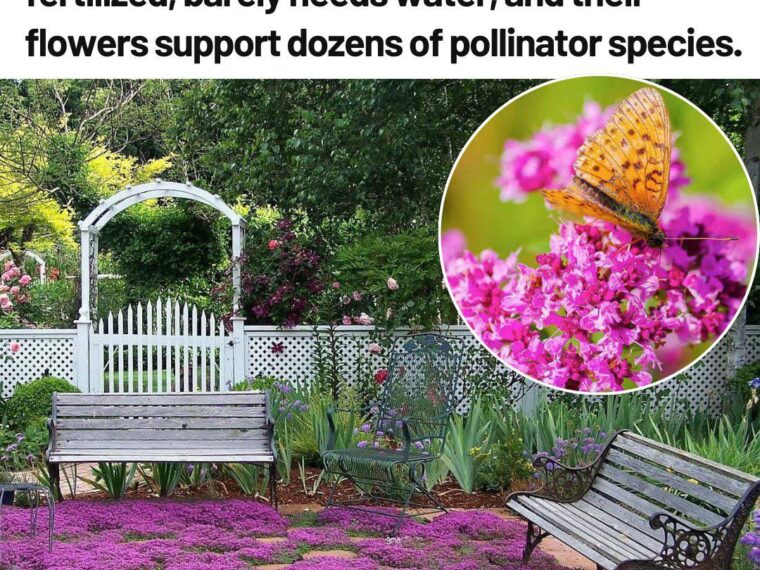This plant is drought-tolerant, pollinator-friendly, and perfect for areas where traditional grass struggles.
Looking to replace your traditional lawn grass with something more vibrant and low-maintenance? Consider planting a creeping thyme lawn!
Red creeping thyme (Thymus serpyllum) is a versatile ground cover that forms a lush, dense mat of fragrant foliage. It blooms with small, pinkish-red flowers, offering a colorful and eco-friendly alternative to plain grass.
In this article, we’ll explore the benefits and drawbacks of a creeping thyme lawn and provide a step-by-step guide to help you plant it successfully.
What Is Red Creeping Thyme?
Red creeping thyme is a low-growing perennial herb that spreads across the ground, creating a dense carpet of aromatic leaves.
Its small pink-red flowers add a splash of color, making it a striking alternative to traditional lawn grass.
This plant is drought-tolerant, attracts pollinators, and thrives in places where grass often struggles to grow.
Benefits of a Creeping Thyme Lawn
1. Low Maintenance
Unlike grass, creeping thyme requires minimal mowing—just occasional trimming if you want to keep it neat. It stays compact and reduces upkeep needs.
2. Drought-Tolerant
Creeping thyme thrives in hot, dry conditions, making it an excellent choice for regions prone to drought. It doesn’t need frequent watering to stay healthy.
3. Attracts Pollinators
Its red flowers attract beneficial insects like bees and butterflies, helping your garden flourish and supporting local ecosystems.
4. Fragrant and Attractive
When stepped on or brushed, creeping thyme releases a pleasant herbal scent. Its flowers add a lovely burst of color to your landscape.
5. Prevents Soil Erosion
The dense growth helps stabilize soil and prevents erosion, especially on slopes or uneven terrain.
Drawbacks of a Creeping Thyme Lawn
1. Slow Establishment
Creeping thyme grows slowly, so it may take several months to fully cover the area. Patience is key.
2. Not Suitable for Heavy Foot Traffic
Though hardy, creeping thyme doesn’t withstand constant heavy foot traffic well. It’s better suited for lightly used spaces or garden paths.
3. Doesn’t Tolerate Shade Well
It prefers full sun and struggles in heavily shaded spots, limiting where you can plant it successfully.
4. Higher Upfront Cost
Compared to grass seed, purchasing thyme plants or plugs can be more expensive initially. However, savings on water and maintenance balance this out over time.
How to Plant a Creeping Thyme Lawn
1. Prepare the Soil
- Remove weeds, grass, and debris.
- Loosen the soil to improve drainage and add compost if needed.
- Thyme prefers slightly alkaline to neutral soil (pH 6.5–7.5).
2. Choose Your Planting Method
- Seeds: Sow evenly, then lightly cover with soil or compost.
- Plants or Cuttings: Space them 8–12 inches apart to allow spreading.
3. Water Consistently
Water lightly but regularly until plants are established. Once rooted, thyme is drought-tolerant, so reduce watering to avoid overwatering.
4. Provide Plenty of Sunlight
Plant thyme in areas that receive at least 6–8 hours of direct sunlight daily. Avoid heavy shade.
5. Mulch to Suppress Weeds
Apply a thin layer of mulch between plants to retain moisture and prevent weed growth as thyme spreads.
6. Trim Occasionally (Optional)
While thyme doesn’t need regular mowing, you can trim it lightly after flowering to keep it tidy.
Best Uses for Creeping Thyme Lawns
- Paths and Walkways: Ideal for light foot traffic areas.
- Between Pavers: Fill gaps between stepping stones for a lush, aromatic effect.
- Slopes or Erosion-Prone Areas: Stabilize soil with thyme’s dense mat.
- Pollinator Gardens: Attract bees and butterflies to your garden.
Switching from traditional grass to creeping thyme is a wonderful way to create a beautiful, eco-friendly, and easy-to-maintain lawn.





